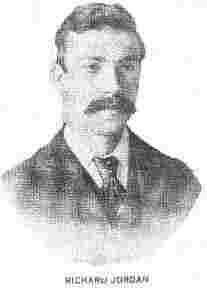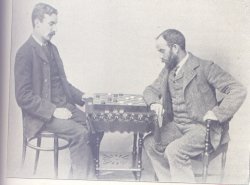Richard Jordan (1872-1911)
by Norrie Reid
 The greatest draughts player of all time was probably Richard Jordan who was born in Edinburgh
on the 4th of November 1872. Like Ferrie, Jordan came from an Irish
family recently domiciled in Scotland. His study of the game began when he was 15, and within
three years he won the championship of his native city. He was challenged by Mr P Scott in 1889,
with the result Jordan 4, Scott 0 and one draw. In the Wyllie
handicap medal competition, one open to all players who had played Mr Wyllie,
Jordan defeated W Porte, an internationalist, by 2-0-4. His abilities were recognised by Mr J
Whyte, the then enegetic secretary of the Edinburgh Draughts Club, who arranged a match of
twenty games and £20 with James Wyllie, the "Herd Laddie". Richard
surprised the World, but not Mr Whyte, by defeating the old master 2-1-17. This took place in
Edinburgh during May of 1892. His next match was against Mr Robert Fraser, champion of Dundee,
again for £20; played at Dundee in November 1892, Jordan won 6-2-9 (wins-losses-draws).
The greatest draughts player of all time was probably Richard Jordan who was born in Edinburgh
on the 4th of November 1872. Like Ferrie, Jordan came from an Irish
family recently domiciled in Scotland. His study of the game began when he was 15, and within
three years he won the championship of his native city. He was challenged by Mr P Scott in 1889,
with the result Jordan 4, Scott 0 and one draw. In the Wyllie
handicap medal competition, one open to all players who had played Mr Wyllie,
Jordan defeated W Porte, an internationalist, by 2-0-4. His abilities were recognised by Mr J
Whyte, the then enegetic secretary of the Edinburgh Draughts Club, who arranged a match of
twenty games and £20 with James Wyllie, the "Herd Laddie". Richard
surprised the World, but not Mr Whyte, by defeating the old master 2-1-17. This took place in
Edinburgh during May of 1892. His next match was against Mr Robert Fraser, champion of Dundee,
again for £20; played at Dundee in November 1892, Jordan won 6-2-9 (wins-losses-draws).
At the first Scottish Championship Tournament of 1893 he suffered the only setback of his
playing career when he was eliminated in the second round by Robert Stewart
by 1-2-9. This stung Richard into an immediate challenge to Stewart.
This lead to a match for £50 in the Cooperative Hall, Dunfermline, during 1893, Jordan winning
easily 4-0-13. The same year he played JC Brown the "Border Champion" in a match for £50, best
of thirty games. This he won brilliantly 7-2-17.
 Richard won the Scottish Tournament of 1896, the second and last time he entered, norrowly
defeating the then World Champion, James Ferrie; so a match between
the two was arranged. From this Jordan emerged with the title by 4-3-33. The photograph on the
left is taken from this match and shows Jordan seated on the left. He successfully
defended the title against Robert Stewart, Charles Barker of America, and Harry
Freedman of Glasgow before retiring from the World Championship matches in 1903. This did not
however mark the end of his career, for in 1905 he played against the USA, achieving the
outstanding score of 13-0-27 better than any of the other competitors. The match was won by the
British team, 74-34-283, and this magnificent result was mainly due to the Scottish group of
six out of the ten players: R Jordan (Edinburgh), J Searight
(Glasgow), R Stewart (Kelty), G Buchanan
(Glasgow), J Ferrie (Glasgow) and A Hynd (born in Dunfermline Scotland
and a relation of Robert Stewart, although an emigre to England).
Richard won the Scottish Tournament of 1896, the second and last time he entered, norrowly
defeating the then World Champion, James Ferrie; so a match between
the two was arranged. From this Jordan emerged with the title by 4-3-33. The photograph on the
left is taken from this match and shows Jordan seated on the left. He successfully
defended the title against Robert Stewart, Charles Barker of America, and Harry
Freedman of Glasgow before retiring from the World Championship matches in 1903. This did not
however mark the end of his career, for in 1905 he played against the USA, achieving the
outstanding score of 13-0-27 better than any of the other competitors. The match was won by the
British team, 74-34-283, and this magnificent result was mainly due to the Scottish group of
six out of the ten players: R Jordan (Edinburgh), J Searight
(Glasgow), R Stewart (Kelty), G Buchanan
(Glasgow), J Ferrie (Glasgow) and A Hynd (born in Dunfermline Scotland
and a relation of Robert Stewart, although an emigre to England).
Jordan was a slightly built, dark eyed and dark haired man. He was swift, intuitive and
aggressive in his movements. He was also a fine chess player and often represented Edinburgh.
This chess playing ability is common among draughts players; James Ferrie
was also a first rate player - he represented Glasgow against Edinburgh! Other notable
chess/draughts players included AB Scott from Govan, Glasgow and the Americans Harry Pilsbury
and Newell Banks. After retiring from match play Richard Jordan toured the World, like
James Wyllie before him, where in exhibition play he showed himself
to be at the peak of his powers.
During April and May of 1911 we find him touring the North of England giving simultaneous
displays as follows:-
29th April at Dinnington (52-1-11)
29th April at Shields (40-0-8)
3rd May at the Pillars Cafe in Newcastle (26-0-11)
6th May at Stanley (83-2-14)
6th May at Throckley (41-0-4)
9th May at the Black Bull Hotel in Wallsend (58-0-11)
9th May at the Pillars Cafe in Newcastle (24-0-6)
9th May at Stanley (23-1-8)
13th May at Mickley (53-1-10)
13th May at the King Edward Hotel in Newcastle (28-0-12)
13th May at the Working Men's Club in Newcastle (16-1-9)
20th May at Shields (28-3-6)
Total score: 472-10-110
The rest of May saw lesser engagements at Birtley, Newcastle and Sunderland. In June he would
be in Manchester, Sheffield, Leeds and Morley.
It was a tragedy that while still young and a wonderful player he was accidentally struck by a
tram-car near his home in Edinburgh. Seemingly not seriously injured, he was released from the
Infirmary but suffered a relapse shortly after and died after an operation in September 1911.
After a funeral service at his home at 33 Buccleuch Street, he was buried at the New Calton
Cemetery, Edinburgh. His family having been left destitute, there is no headstone, but his
grave can be found in the bottom corner, immediately behind the stone marked Mrs C Finniegan,
by the hedge on the wall.
 Richard won the Scottish Tournament of 1896, the second and last time he entered, norrowly
defeating the then World Champion, James Ferrie; so a match between
the two was arranged. From this Jordan emerged with the title by 4-3-33. The photograph on the
left is taken from this match and shows Jordan seated on the left. He successfully
defended the title against Robert Stewart, Charles Barker of America, and Harry
Freedman of Glasgow before retiring from the World Championship matches in 1903. This did not
however mark the end of his career, for in 1905 he played against the USA, achieving the
outstanding score of 13-0-27 better than any of the other competitors. The match was won by the
British team, 74-34-283, and this magnificent result was mainly due to the Scottish group of
six out of the ten players: R Jordan (Edinburgh), J Searight
(Glasgow), R Stewart (Kelty), G Buchanan
(Glasgow), J Ferrie (Glasgow) and A Hynd (born in Dunfermline Scotland
and a relation of Robert Stewart, although an emigre to England).
Richard won the Scottish Tournament of 1896, the second and last time he entered, norrowly
defeating the then World Champion, James Ferrie; so a match between
the two was arranged. From this Jordan emerged with the title by 4-3-33. The photograph on the
left is taken from this match and shows Jordan seated on the left. He successfully
defended the title against Robert Stewart, Charles Barker of America, and Harry
Freedman of Glasgow before retiring from the World Championship matches in 1903. This did not
however mark the end of his career, for in 1905 he played against the USA, achieving the
outstanding score of 13-0-27 better than any of the other competitors. The match was won by the
British team, 74-34-283, and this magnificent result was mainly due to the Scottish group of
six out of the ten players: R Jordan (Edinburgh), J Searight
(Glasgow), R Stewart (Kelty), G Buchanan
(Glasgow), J Ferrie (Glasgow) and A Hynd (born in Dunfermline Scotland
and a relation of Robert Stewart, although an emigre to England).
 The greatest draughts player of all time was probably Richard Jordan who was born in Edinburgh
on the 4th of November 1872. Like Ferrie, Jordan came from an Irish
family recently domiciled in Scotland. His study of the game began when he was 15, and within
three years he won the championship of his native city. He was challenged by Mr P Scott in 1889,
with the result Jordan 4, Scott 0 and one draw. In the Wyllie
handicap medal competition, one open to all players who had played Mr Wyllie,
Jordan defeated W Porte, an internationalist, by 2-0-4. His abilities were recognised by Mr J
Whyte, the then enegetic secretary of the Edinburgh Draughts Club, who arranged a match of
twenty games and £20 with James Wyllie, the "Herd Laddie". Richard
surprised the World, but not Mr Whyte, by defeating the old master 2-1-17. This took place in
Edinburgh during May of 1892. His next match was against Mr Robert Fraser, champion of Dundee,
again for £20; played at Dundee in November 1892, Jordan won 6-2-9 (wins-losses-draws).
The greatest draughts player of all time was probably Richard Jordan who was born in Edinburgh
on the 4th of November 1872. Like Ferrie, Jordan came from an Irish
family recently domiciled in Scotland. His study of the game began when he was 15, and within
three years he won the championship of his native city. He was challenged by Mr P Scott in 1889,
with the result Jordan 4, Scott 0 and one draw. In the Wyllie
handicap medal competition, one open to all players who had played Mr Wyllie,
Jordan defeated W Porte, an internationalist, by 2-0-4. His abilities were recognised by Mr J
Whyte, the then enegetic secretary of the Edinburgh Draughts Club, who arranged a match of
twenty games and £20 with James Wyllie, the "Herd Laddie". Richard
surprised the World, but not Mr Whyte, by defeating the old master 2-1-17. This took place in
Edinburgh during May of 1892. His next match was against Mr Robert Fraser, champion of Dundee,
again for £20; played at Dundee in November 1892, Jordan won 6-2-9 (wins-losses-draws).